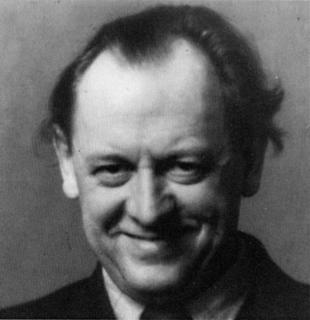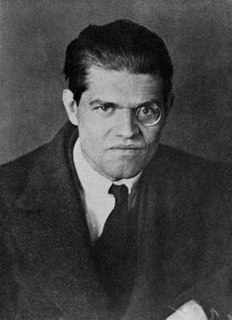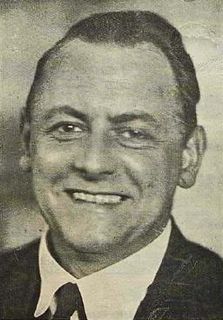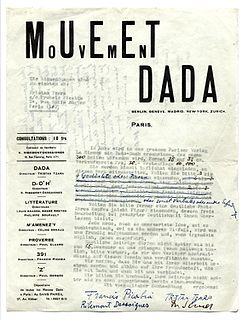
Dada or Dadaism was an art movement of the European avant-garde in the early 20th century, with early centres in Zürich, Switzerland, at the Cabaret Voltaire. New York Dada began c. 1915, and after 1920 Dada flourished in Paris. Dadaist activities lasted until c. the mid 1920s.

Kurt Hermann Eduard Karl Julius Schwitters was a German artist who was born in Hanover, Germany.

Tristan Tzara was a Romanian and French avant-garde poet, essayist and performance artist. Also active as a journalist, playwright, literary and art critic, composer and film director, he was known best for being one of the founders and central figures of the anti-establishment Dada movement. Under the influence of Adrian Maniu, the adolescent Tzara became interested in Symbolism and co-founded the magazine Simbolul with Ion Vinea and painter Marcel Janco. During World War I, after briefly collaborating on Vinea's Chemarea, he joined Janco in Switzerland. There, Tzara's shows at the Cabaret Voltaire and Zunfthaus zur Waag, as well as his poetry and art manifestos, became a main feature of early Dadaism. His work represented Dada's nihilistic side, in contrast with the more moderate approach favored by Hugo Ball.
Hans Richter was a German painter, graphic artist, avant-gardist, film-experimenter and producer. He was born in Berlin into a well-to-do family and died in Minusio, near Locarno, Switzerland.

Raoul Hausmann was an Austrian artist and writer. One of the key figures in Berlin Dada, his experimental photographic collages, sound poetry, and institutional critiques would have a profound influence on the European Avant-Garde in the aftermath of World War I.
— Opening lines from The Waste Land by T. S. Eliot, first published this year

Der Sturm was a German art and literary magazine founded by Herwarth Walden, covering Expressionism, Cubism, Dada and Surrealism, among other artistic movements. It was published between 1910 and 1932.
—From A Prayer for My Daughter by W. B. Yeats, written on the birth of his daughter Anne on February 26

Universal War is an artist's book by Aleksei Kruchenykh published in Petrograd at the beginning of 1916. Despite being produced in an edition of 100 of which only 12 are known to survive, the book has become one of the most famous examples of Russian Futurist book production, and is considered a seminal example of avant-garde art from the beginning of the twentieth century.
Punct is a Romanian art and literary magazine published from 1924 to 1925.
Otto Nebel was a German painter born in Berlin, Germany.
Leah Dickerman is the Director of Editorial & Content Strategy at The Museum of Modern Art (MoMA) in New York City. Serving most recently as the Museum’s first Marlene Hess Curator of Painting and Sculpture, a post endowed in 2015, Dickerman previously held the positions of Curator of Painting and Sculpture at MoMA (2008-2015), Acting Head of the Department of Modern and Contemporary Art at the National Gallery of Art (NGA), Washington, D.C. (2007), and Associate Curator in Modern and Contemporary Art at the NGA (2001-2007). Over the course of her career, Dickerman has organized or co-organized a series of exhibitions including One-Way Ticket: Jacob Lawrence's Migration Series and Other Works (2015), Inventing Abstraction, 1910-1925 (2012-2013), Diego Rivera: Murals for the Museum of Modern Art (2011-2012), Bauhaus: Workshops for Modernity (2009-2010), Dada (2005-2006), and Aleksandr Rodchenko (1998).

Dragan Aleksić was a Serbian Dadaist poet, author, journalist and filmmaker. He was the founder of the Yugoslavian branch of Dadaism, termed "Yugo-Dada".

Merz is a synonym for the more common expression and term Dada, and traces back to Kurt Schwitters.
Ludwig Bäumer was a German writer and Communist activist.

Dadaglobe was an anthology of the Dada movement slated for publication in 1921, but abandoned for financial and other reasons and never published. At 160 pages with over a hundred reproductions of artworks and over a hundred texts by some fifty artists in ten countries, Dadaglobe was to have documented Dada's apogee as an artistic and literary movement of international breadth. Edited by Dada co-founder Tristan Tzara (1896-1963) in Paris, Dadaglobe was not conceived as a summary of the movement since its founding in 1916, but rather meant to be a snapshot of its expanded incarnation at war's end. Not merely a vehicle for existing works, the project functioned as one of Dada's most generative catalysts for the production of new works.
Salomo Friedlaender was a German-Jewish philosopher, poet, satirist and author of grotesque and fantastic literature. He published his literary work under the pseudonym Mynona, which is the German word for “anonymous” spelled backward. He is known for his philosophical ideas on dualism drawing on Immanuel Kant, and his avant garde poetry and fiction. Almost none of his work has been translated into English.
Hanne Bergius is a German art historian and Professor for Art History with emphases on art, photography, modern design and architecture.

Dada Tank was a Yugoslav Dadaist single issue publication published in Zagreb in June 1922 and edited by Dragan Aleksić. Aleksić published Dada Tank as a response to Branko Ve Poljanski and his brother Ljubomir Micić's anti-Dada publication Dada-Jok from May 1922.

Nelly Anna Charlotta Walden was a Swedish painter, art collector, and writer. A key figure in the activities of Berlin-based avant-garde magazine Der Sturm, Walden was a pioneer of abstract art and was married to German writer Herwarth Walden.
![The poem on the "Anna-Blume-Brunnen" by Max Sauk [de] at the Muhlenberger Markt, Muhlenberg (Hannover) [de]. An Anna Blume Merz-Gedicht von Kurt Schwitters von 1919; Anna-Blume-Brunnen von Max Sauk, 1986, Muhlenberger Markt, Hannover Muhlenberg.jpg](http://upload.wikimedia.org/wikipedia/commons/thumb/f/f3/An_Anna_Blume_Merz-Gedicht_von_Kurt_Schwitters_von_1919%3B_Anna-Blume-Brunnen_von_Max_Sauk%2C_1986%2C_M%C3%BChlenberger_Markt%2C_Hannover_M%C3%BChlenberg.jpg/330px-An_Anna_Blume_Merz-Gedicht_von_Kurt_Schwitters_von_1919%3B_Anna-Blume-Brunnen_von_Max_Sauk%2C_1986%2C_M%C3%BChlenberger_Markt%2C_Hannover_M%C3%BChlenberg.jpg)












